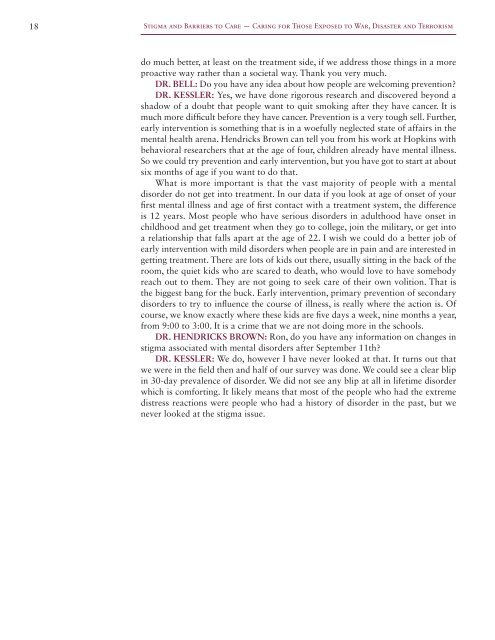stigma and barriers to care - Uniformed Services University of the ...
stigma and barriers to care - Uniformed Services University of the ...
stigma and barriers to care - Uniformed Services University of the ...
You also want an ePaper? Increase the reach of your titles
YUMPU automatically turns print PDFs into web optimized ePapers that Google loves.
18<br />
Stigma <strong>and</strong> Barriers <strong>to</strong> Care — Caring for Those Exposed <strong>to</strong> War, Disaster <strong>and</strong> Terrorism<br />
do much better, at least on <strong>the</strong> treatment side, if we address those things in a more<br />
proactive way ra<strong>the</strong>r than a societal way. Thank you very much.<br />
DR. BELL: Do you have any idea about how people are welcoming prevention<br />
DR. KESSLER: Yes, we have done rigorous research <strong>and</strong> discovered beyond a<br />
shadow <strong>of</strong> a doubt that people want <strong>to</strong> quit smoking after <strong>the</strong>y have cancer. It is<br />
much more difficult before <strong>the</strong>y have cancer. Prevention is a very <strong>to</strong>ugh sell. Fur<strong>the</strong>r,<br />
early intervention is something that is in a woefully neglected state <strong>of</strong> affairs in <strong>the</strong><br />
mental health arena. Hendricks Brown can tell you from his work at Hopkins with<br />
behavioral researchers that at <strong>the</strong> age <strong>of</strong> four, children already have mental illness.<br />
So we could try prevention <strong>and</strong> early intervention, but you have got <strong>to</strong> start at about<br />
six months <strong>of</strong> age if you want <strong>to</strong> do that.<br />
What is more important is that <strong>the</strong> vast majority <strong>of</strong> people with a mental<br />
disorder do not get in<strong>to</strong> treatment. In our data if you look at age <strong>of</strong> onset <strong>of</strong> your<br />
first mental illness <strong>and</strong> age <strong>of</strong> first contact with a treatment system, <strong>the</strong> difference<br />
is 12 years. Most people who have serious disorders in adulthood have onset in<br />
childhood <strong>and</strong> get treatment when <strong>the</strong>y go <strong>to</strong> college, join <strong>the</strong> military, or get in<strong>to</strong><br />
a relationship that falls apart at <strong>the</strong> age <strong>of</strong> 22. I wish we could do a better job <strong>of</strong><br />
early intervention with mild disorders when people are in pain <strong>and</strong> are interested in<br />
getting treatment. There are lots <strong>of</strong> kids out <strong>the</strong>re, usually sitting in <strong>the</strong> back <strong>of</strong> <strong>the</strong><br />
room, <strong>the</strong> quiet kids who are s<strong>care</strong>d <strong>to</strong> death, who would love <strong>to</strong> have somebody<br />
reach out <strong>to</strong> <strong>the</strong>m. They are not going <strong>to</strong> seek <strong>care</strong> <strong>of</strong> <strong>the</strong>ir own volition. That is<br />
<strong>the</strong> biggest bang for <strong>the</strong> buck. Early intervention, primary prevention <strong>of</strong> secondary<br />
disorders <strong>to</strong> try <strong>to</strong> influence <strong>the</strong> course <strong>of</strong> illness, is really where <strong>the</strong> action is. Of<br />
course, we know exactly where <strong>the</strong>se kids are five days a week, nine months a year,<br />
from 9:00 <strong>to</strong> 3:00. It is a crime that we are not doing more in <strong>the</strong> schools.<br />
DR. HENDRICKS BROWN: Ron, do you have any information on changes in<br />
<strong>stigma</strong> associated with mental disorders after September 11th<br />
DR. KESSLER: We do, however I have never looked at that. It turns out that<br />
we were in <strong>the</strong> field <strong>the</strong>n <strong>and</strong> half <strong>of</strong> our survey was done. We could see a clear blip<br />
in 30-day prevalence <strong>of</strong> disorder. We did not see any blip at all in lifetime disorder<br />
which is comforting. It likely means that most <strong>of</strong> <strong>the</strong> people who had <strong>the</strong> extreme<br />
distress reactions were people who had a his<strong>to</strong>ry <strong>of</strong> disorder in <strong>the</strong> past, but we<br />
never looked at <strong>the</strong> <strong>stigma</strong> issue.




